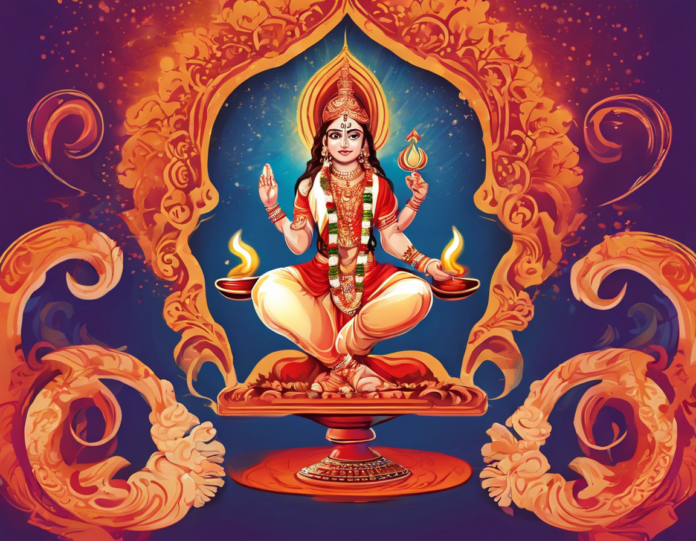Introduction:
In the Hindu tradition, divine grace holds immense significance. It refers to the divine assistance, intervention, or a benevolent force bestowed upon individuals by the divine or deities. Among the various forms of expressing devotion and seeking divine grace, singing aartis is a common practice. One such popular aarti is the “Ambe Ji Ki Aarti,” dedicated to Goddess Amba or Amba Mata, also known as Durga or Ambe Mata.
Understanding the Significance:
The Ambe Ji Ki Aarti is a devotional song sung in praise of Goddess Amba, seeking her blessings, protection, and grace. This aarti is typically performed in temples, during festivals like Navratri, and in homes by devotees seeking the goddess’s benevolence.
The Verses and Their Meanings:
The Ambe Ji Ki Aarti consists of verses that describe the various attributes and forms of Goddess Amba. Each verse carries deep symbolism and conveys aspects of her divine persona. Here is a breakdown of some key verses and their meanings:
- Om Jai Ambe Gauri:
- This opening verse hails Goddess Amba as Gauri, meaning fair or radiant. It is a salutation to her divine beauty and grace.
- Maya Jaya Ambe:
- This verse acknowledges the goddess’s role as Maya, signifying the illusory nature of the material world. It seeks her blessings to transcend this illusion and attain spiritual enlightenment.
- Jai Ambe Jai Jagdambe:
- Here, the devotee extols Goddess Amba as the universal mother, Jagadamba, who nurtures and protects all beings in the cosmos.
- Brahmani, Rudrani, Tum Kamala Rani:
- These lines honor Goddess Amba as Brahmani, the consort of Brahma, and Rudrani, the consort of Shiva. It recognizes her as the queen of the lotus (Kamala Rani), symbolizing purity and divinity.
Seeking Divine Blessings:
Through the Ambe Ji Ki Aarti, devotees seek various blessings from the goddess, such as:
– Protection from evil forces and negativity.
– Strength to overcome obstacles and challenges.
– Guidance in leading a righteous and fulfilling life.
– Granting of wishes and desires.
– Bestowing peace, prosperity, and happiness.
Rituals and Practices:
The Ambe Ji Ki Aarti is typically performed with traditional rituals and practices, including:
– Lighting incense sticks and lamps as offerings to the goddess.
– Circulating the aarti plate in a clockwise direction as a gesture of reverence.
– Singing the aarti with devotion and concentration.
– Concluding with prayers for the goddess’s blessings and grace.
Conclusion:
In essence, the Ambe Ji Ki Aarti is a powerful invocation to Goddess Amba, seeking her divine grace and benevolence. It encapsulates the essence of devotion, gratitude, and surrender to the divine mother, embodying the belief in her protective and nurturing presence in one’s life.
FAQs:
- What is the significance of singing aartis in Hindu worship?
-
Aartis are a form of devotional singing that express reverence, gratitude, and seeking blessings from deities. They create a sacred ambiance and deepen the devotee’s connection with the divine.
-
Can anyone perform the Ambe Ji Ki Aarti at home?
-
Yes, devotees can perform the Ambe Ji Ki Aarti at home with sincerity and devotion. It is a way to invite the goddess’s presence into one’s household and seek her blessings.
-
Is Goddess Amba worshipped differently in different regions of India?
-
Yes, the worship of Goddess Amba may vary in rituals and customs across different regions, but her essence as the divine mother remains central to all practices.
-
What are the benefits of chanting the Ambe Ji Ki Aarti regularly?
-
Regular chanting of the aarti can bring peace of mind, protection from negative energies, fulfillment of desires, and spiritual upliftment to the devotee.
-
Are there specific days or festivals when the Ambe Ji Ki Aarti is considered especially auspicious?
-
The Navratri festival, particularly the Sharad Navratri, is a significant time for chanting the Ambe Ji Ki Aarti as it honors the divine feminine energy and celebrates the victory of good over evil.
-
Can non-Hindus also participate in singing the Ambe Ji Ki Aarti?
-
Yes, the Ambe Ji Ki Aarti is a universal prayer for seeking divine grace and blessings. Non-Hindus are welcome to participate in the singing of this aarti with respect and reverence.
-
What role does faith play in seeking divine grace through rituals like the Ambe Ji Ki Aarti?
-
Faith is a crucial aspect of any devotional practice. It is the unwavering belief and trust in the divine power’s benevolence and the efficacy of rituals that enhances the seeker’s connection with the divine.
-
How can one enhance their spiritual experience while performing the Ambe Ji Ki Aarti?
-
To enhance the spiritual experience, one can focus on understanding the meanings of the aarti verses, maintain a meditative state while singing, and cultivate a sense of surrender and devotion towards the goddess.
-
Are there specific mantras or prayers associated with Goddess Amba apart from the Ambe Ji Ki Aarti?
-
Yes, there are several mantras dedicated to Goddess Amba, such as the Durga Chalisa, Durga Stuti, and Devi Mahatmyam. These mantras can be chanted for invoking the goddess’s blessings and protection.
-
How does the symbolism used in the Ambe Ji Ki Aarti verses help deepen the devotee’s understanding of Goddess Amba’s divine attributes?
- The symbolism in the aarti verses conveys profound meanings about the goddess’s qualities, powers, and cosmic significance. Understanding these symbols enriches the devotee’s spiritual connection with Goddess Amba and fosters a deeper appreciation for her divine grace.




